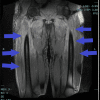A Case of Antisynthetase Syndrome in the Setting of SARS-Cov-2 Infection
- PMID: 37337554
- PMCID: PMC10277010
- DOI: 10.7759/cureus.40588
A Case of Antisynthetase Syndrome in the Setting of SARS-Cov-2 Infection
Abstract
Antisynthetase syndrome is a complex autoimmune disorder, and one of the key criteria for diagnosis is the presence of myositis. Additionally, evidence of interstitial lung disease (ILD) is another important indicator for diagnosis; other clinical features associated with antisynthetase syndrome include arthritis, unexplained and persistent fever, Raynaud's phenomenon, and the presence of mechanic's hands. We report a case of a 36-year-old male who presented to the emergency department with shortness of breath and proximal muscle weakness in the setting of severe acute respiratory syndrome coronavirus 2 (SARS-Cov-2) infection, as his inflammatory markers were elevated and he exhibited features suspicious for antisynthetase syndrome, he was started on methylprednisolone 40 mg intravenously every eight hours, and a myositis panel was checked. In addition, a chest computed tomography (CT) exhibited ground-glass opacities which were compatible with coronavirus disease 2019 (COVID-19). A magnetic resonance image (MRI) of both thighs was done, revealing significant swelling and confirming the suspicion of myositis as his muscle strength in his lower extremities took significant time to improve. As days passed, his muscle strength improved significantly and his creatine phosphatase kinase (CPK) values trended down, indicating that his myositis was improving as well. He was transitioned to oral prednisone 60 mg daily and was discharged home with a rheumatology follow-up to define long-term treatment. A myositis panel revealed anti-glycyl-transferRNA synthetase (EJ) autoantibody positivity and a diagnosis was established. Our case revealed how sometimes laboratory values do not necessarily correlate with disease severity and how we have to do a thorough history of present illness and physical exam to think about unusual diagnoses before putting laboratory data into context.
Keywords: anti synthetase syndrome; anti-ej antibody; anti-jo-1 antibodies; inflammatory myositis; mechanic hands.
Copyright © 2023, Peña et al.
Conflict of interest statement
The authors have declared that no competing interests exist.
Figures



Similar articles
-
Anti-synthase syndrome associated with SARS-Cov-2 infection.BMC Pulm Med. 2024 Apr 15;24(1):179. doi: 10.1186/s12890-024-02966-2. BMC Pulm Med. 2024. PMID: 38622599 Free PMC article.
-
A Clinical Case of Polymyositis Complicated by Antisynthetase Syndrome.Cureus. 2021 Jan 16;13(1):e12737. doi: 10.7759/cureus.12737. Cureus. 2021. PMID: 33614339 Free PMC article.
-
Diffuse Alveolar Hemorrhage Associated With Anti-PL-7 Antisynthetase Syndrome: A Case Report.Case Rep Pulmonol. 2025 Jan 17;2025:3715449. doi: 10.1155/crpu/3715449. eCollection 2025. Case Rep Pulmonol. 2025. PMID: 39867814 Free PMC article.
-
Myositis-related interstitial lung disease and antisynthetase syndrome.J Bras Pneumol. 2011 Jan-Feb;37(1):100-9. doi: 10.1590/s1806-37132011000100015. J Bras Pneumol. 2011. PMID: 21390438 Free PMC article. Review.
-
[Antisynthetase syndromes].Z Rheumatol. 2019 Sep;78(7):645-655. doi: 10.1007/s00393-019-0665-0. Z Rheumatol. 2019. PMID: 31346706 Review. German.
Cited by
-
Anti-OJ antibody-positive anti-synthetase syndrome following SARS-CoV-2 infection: a case report and literature review.BMC Rheumatol. 2024 Aug 29;8(1):37. doi: 10.1186/s41927-024-00406-6. BMC Rheumatol. 2024. PMID: 39198878 Free PMC article.
-
Anti-PL-7/PL-12 antisynthetase syndrome associated with interstitial lung disease following SARS-COV-2 infection and vaccination: A case study review.Heliyon. 2024 Dec 30;11(2):e41311. doi: 10.1016/j.heliyon.2024.e41311. eCollection 2025 Jan 30. Heliyon. 2024. PMID: 39906838 Free PMC article.
-
A Case of Anti-Synthetase Syndrome With Anti-Glycyl tRNA Synthetases Antibody Developed After COVID-19.Cureus. 2024 Apr 10;16(4):e58004. doi: 10.7759/cureus.58004. eCollection 2024 Apr. Cureus. 2024. PMID: 38738103 Free PMC article.
-
Anti-synthase syndrome associated with SARS-Cov-2 infection.BMC Pulm Med. 2024 Apr 15;24(1):179. doi: 10.1186/s12890-024-02966-2. BMC Pulm Med. 2024. PMID: 38622599 Free PMC article.
-
[Analysis of clinical features of ruccrent interstitial lung disease in patients with anti-EJ positive antisynthetase syndrome].Beijing Da Xue Xue Bao Yi Xue Ban. 2024 Dec 18;56(6):980-986. doi: 10.19723/j.issn.1671-167X.2024.06.006. Beijing Da Xue Xue Bao Yi Xue Ban. 2024. PMID: 39690758 Free PMC article. Chinese.
References
Publication types
LinkOut - more resources
Full Text Sources
Research Materials
Miscellaneous
